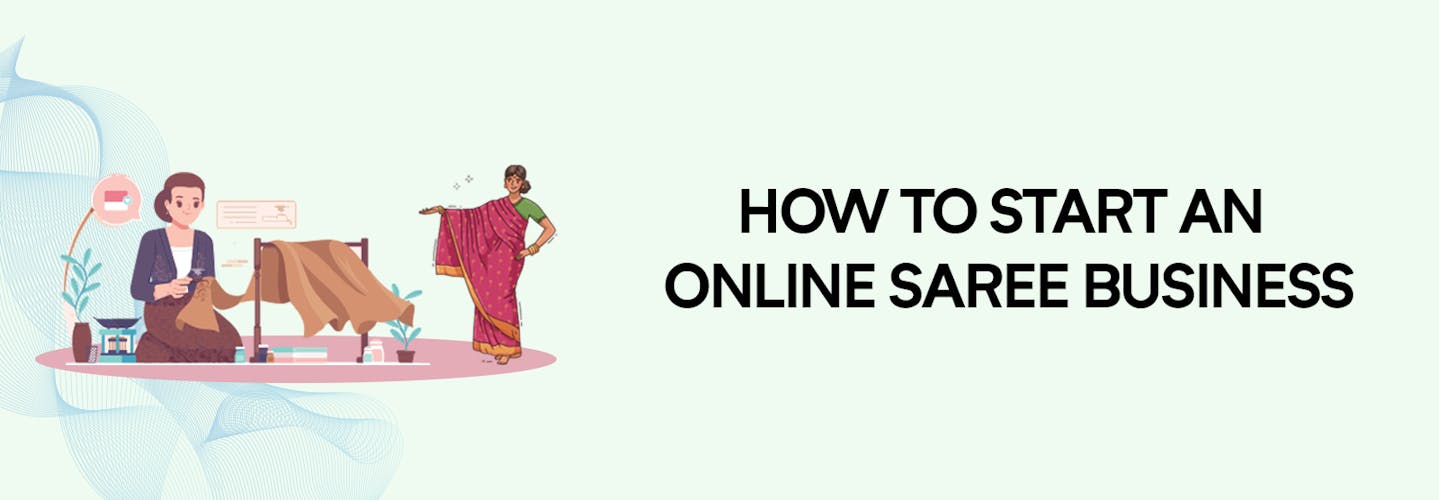
Step-by-Step Guide to Starting an Online Saree Business in India
Are you passionate about sarees and dream of starting your own online business?
Well, you’re in the right place!
In this guide, we’ll walk you through the essential steps to kickstart your online saree business and pave the way for success.
Whether you’re a saree enthusiast or an entrepreneur looking to tap into the booming market of ethnic fashion, we’ve got you covered.
From sourcing exquisite sarees to building a captivating online presence, we’ll share valuable insights and practical tips to help you establish and grow your venture.
So, grab a cup of tea, get comfortable, and let’s dive into the exciting world of starting an online saree business!
Sarees are a traditional garment worn by women in South Asia.
The saree business has been around for centuries and is still thriving today.
With the rise of e-commerce, starting an online saree business has become a lucrative opportunity for entrepreneurs.
Explanation of the Saree Business

Sarees are a versatile garment that can be worn for any occasion. They come in various fabrics, colors, and designs to suit different tastes and preferences.
The saree business involves sourcing high-quality materials, designing unique patterns, and selling them through various channels such as traditional retail stores or online platforms.
The demand for sarees is not limited to South Asia but is also popular among women worldwide who appreciate the beauty and elegance of these garments.
Therefore, starting a saree business can be profitable since it caters to a diverse customer base.
Importance of Online Saree Business
The online marketplace provides numerous benefits for those looking to start a saree business.
Firstly, it offers an opportunity to reach customers from all over the world without geographical limitations.
Secondly, online businesses have lower overhead costs compared to brick-and-mortar stores since there is no need for rent or utilities expenses.
Another benefit of starting an online saree business is that it allows you to build an audience through various digital marketing channels such as social media and email marketing.
This helps create brand awareness and drives traffic to your website resulting in increased sales.
Certainly! Let’s dive into the fascinating world of online saree businesses. 🌟
-
Market Size of Sarees in India:
- In financial year 2021, the market size of sarees (including blouse and petticoat) in India amounted to 288 billion Indian rupees This highlights the significant demand for sarees in the country.
- The saree industry encompasses manufacturers, wholesalers, retailers, and exporters. It’s a vast market with immense potential.
-
Growth and Future Trends:
- The Indian saree industry is estimated to be worth around $17 billion and is expected to grow at a CAGR of 7% between 2021 and 2026.
- According to market data analysis, the annual growth rate of sarees is estimated at 8.06% year-on-year during the period from 2018 to 2023
- Sarees hold a significant market share, accounting for 42.22% of the total Indian apparel market in terms of meters
-
Profit Margins:
- Saree businesses typically operate by buying sarees in bulk from wholesalers or manufacturers at low prices and then selling them at a profit.
- [The profit margin in the saree business can range from a minimum of 30% to 50%, and some successful businesses even achieve margins of up to 100-150%
Benefits of Starting an Online Saree Business
Starting an online saree business can be a lucrative venture with several benefits. Here are some key advantages:
-
Wider Reach: Online businesses have the potential to reach a global audience, allowing you to target customers beyond your local area.
-
Lower Costs: Compared to traditional brick-and-mortar stores, online businesses often have lower overhead costs, such as rent and utilities.
-
Convenience: Customers can browse and purchase sarees from the comfort of their homes, leading to a more convenient shopping experience.
-
24/7 Availability: Your online store is accessible 24/7, allowing customers to shop at any time, which can lead to increased sales.
-
Marketing Opportunities: Digital marketing offers a range of opportunities to promote your business, including social media, SEO, and email marketing.
-
Analytics and Insights: Online platforms provide valuable data and insights into customer behavior, which can help you make informed business decisions.
-
Flexibility: Running an online business offers more flexibility in terms of working hours and location compared to a traditional store.
-
Scalability: Online businesses can easily scale up operations to meet growing demand without the need for significant investments in physical infrastructure.
-
Access to Niche Markets: You can target specific niche markets or customer segments that may be difficult to reach through traditional retail channels.
10. Adaptability: Online businesses can quickly adapt to changing market trends and customer preferences, allowing you to stay competitive in the ever-evolving fashion industry.
Starting an online saree business requires careful planning and execution, but with the right strategy, it can be a rewarding and profitable venture.
In the following sections of this guide, we will go into detail about how to start and scale your online saree business.
1. Research and Planning

Market Research: Understanding the demand for sarees
One of the most critical first steps to starting an online saree business is conducting thorough market research.
You must understand who is interested in purchasing sarees, where they are located, and what styles they prefer.
You can gather valuable insights by visiting relevant forums and chat rooms, joining Facebook groups, and even conducting surveys online.
By charting existing trends in popular colors, materials, designs, etc., you can make informed decisions about which products to sell.
You may also want to identify important influencers or celebrities who wear sarees frequently for marketing purposes.
This can help you reach a wide audience with your offerings. Other areas to explore include seasonal trends that might affect demand during certain times of year.
Competitor Analysis: Figuring out what others are doing
As with any business venture, it is essential to analyze your competitors’ strengths and weaknesses before developing your strategy.
By examining other online saree stores, product offerings, pricing strategies, customer service policies and reviews etc., you can detect gaps in the market that you can fill by offering something unique or superior.
You should also pay attention to how your competitors are staying ahead of the curve by watching their social media accounts (Facebook pages, Twitter handles), newsletters et cetera and learning from their latest moves in events or discounts offered.
Don’t forget smaller details like product descriptions that impacts sales as well.
Business Plan Creation: Setting up an effective blueprint
After conducting market research and competitor analysis it’s time to create a detailed business plan outlining all aspects of your online saree business from start till end.
A good business plan should include a mission statement describing what kind of company you wish to build; an executive summary that provides an overview of important financial projections; marketing strategies; product offerings; and a clear distribution plan.
The business plan should also include a SWOT analysis (Strengths, Weaknesses, Opportunities, and Threats) that can help you identify internal and external factors that may impact your business positively or negatively.
This plan will serve as a roadmap for your future, helping you remain focused on the critical path to success.
Brand Identity: Creating a strong online presence
Creating a brand identity is crucial for any online saree business to become recognized as an authority in the industry.
You should choose an effective name, logo and tagline that appeals to your target audience while also reflecting your unique selling proposition.
Developing consistent branding across all channels - such as website design, social media content et cetera - is essential for building trust with potential customers.
It is also beneficial to create unique selling points by identifying what sets your products apart from those of other online stores.
For example, if you specialize in rare or hard-to-find sarees or offer eco-friendly options that appeal to green-conscious buyers that could be your USP.
2. Legal Requirements and Registration

Business registration
One of the most important steps in starting an online saree business is registering your company.
This process will differ depending on your location and the type of business structure you choose, such as a sole proprietorship, partnership, or limited liability company (LLC).
In some countries, you may need to register for a business license with local or state authorities.
This may require submitting paperwork and paying fees. In addition, you will need to register your business name and obtain a tax ID number.
It is essential to do thorough research and consultation with legal experts before selecting a business structure and registering your company.
Choosing the wrong structure can lead to legal issues down the line.
Taxation and legal requirements
Aside from registering your business, you will also need to comply with taxation laws in your country.
Depending on where you are located, this may include sales tax or VAT (value-added tax) registration.
You should consult with an accountant or tax professional who specializes in small businesses to ensure that you comply with all relevant tax laws.
Failing to do so can lead to penalties or even legal trouble. In addition to taxation laws, there may be other legal requirements that come along with selling goods online.
For example, depending on where you are located and where your customers are located, there may be regulations around data protection or consumer protection that you need to comply with.
It is important to stay up-to-date on all relevant legal requirements for your online saree business by regularly consulting with experienced advisors.
Intellectual Property Protection
As an online saree seller, it’s important that you keep track of original designs of yours as well as those created by others from whom the designs have been purchased for resale.
Protecting intellectual property rights such as patents can help safeguard against potential copyright infringement lawsuits.
You should conduct in-depth research to ensure that the designs you use are not already protected by patents or trademarks.
In legal terms, this is called a Freedom to Operate (FTO) analysis. If you do use a design that is protected by someone else’s intellectual property rights, then it could lead to legal troubles such as infringement lawsuits.
Understanding and meeting the legal requirements for your online saree business is crucial for avoiding potential legal issues and running your business smoothly.
Consult with experts and stay informed on any changes in laws or regulations that may affect your operations.
3. Building an Online Presence

Building an online presence is crucial for any business to succeed, especially in the modern era where internet usage has increased exponentially.
When it comes to selling sarees online, building an online presence becomes even more important.
A strong online presence can help you reach a wider audience and increase your sales.
In this section, we’ll discuss three key aspects of building an online presence: website development and design, social media marketing, and search engine optimization.
Website Development and Design
Your website should be your highest priority as it’s the first point of contact between you and your potential customers.
Your website is essentially your shop window that showcases what you have to offer. A well-designed website can help you establish credibility and increase conversions.
When designing your website, keep in mind that it should be easy to navigate and visually appealing.
To create a professional-looking site for your business, consider hiring a web developer or using a website builder platform like Aasaan, Shopify or Wix.
These platforms offer pre-made templates that are customizable according to your needs.
Some key elements that should be included on your website are high-quality images of the sarees you are selling, detailed product descriptions, pricing information, contact details including email address and phone number.
Also Read: 8 Best Shopify Alternatives to Consider (Free, Paid, and Open Source).
Social Media Marketing
Social media platforms such as Facebook and Instagram provide an excellent opportunity for small businesses to promote their products at little or no cost.
By creating social media accounts dedicated to your saree business, you can engage with potential customers by posting images of new arrivals or promotional offers.
Make sure that the content posted on social media aligns with the image portrayed on the website so that they complement each other effectively.
Additionally, try partnering with influencers in the fashion industry who can endorse your products through their followers.
Search Engine Optimization
Search Engine Optimization (SEO) helps improve your website’s ranking on search engines like Google, Bing, and Yahoo.
To improve your website’s SEO, ensure that you have a well-structured website with relevant keywords in the meta description, headers and content.
One way to improve SEO is by creating high-quality content. This can include blog posts about saree styling tips or creating YouTube videos on how to wear sarees.
Additionally, guest posting on other websites can help increase traffic to your site.
Another way to improve your SEO is by building backlinks having other websites link back to your site. This is often done through networking with other businesses or offering discounts for those who share a link to your website.
Building an online presence requires effort and time. By having a professional-looking website, utilizing social media platforms effectively and improving SEO ranking, you can reach a wider audience and increase sales for your online saree business.
4. Sourcing Products

Finding reliable suppliers
Finding a reliable supplier is crucial for any business.
When it comes to sourcing sarees, you want to ensure that you are getting the best quality products at the most competitive prices.
One of the best ways to find a reliable supplier is through referrals from other business owners in your industry.
Attend trade shows and exhibitions to connect with other vendors and learn about their suppliers.
Another way to source reliable suppliers is through online directories and marketplaces such as Alibaba, IndiaMART, or Wholesale Central.
These platforms provide access to verified suppliers from around the world. Be sure to thoroughly research each potential supplier before making any commitments or payments.
Negotiating prices and terms
When negotiating with suppliers, it’s important to establish clear communication and expectations from the outset.
Be upfront about your budget and volume requirements, as this will help both parties arrive at a mutually beneficial agreement.
Make sure to negotiate not only the price of the products but also the payment terms, shipping costs, and delivery timeline.
Consider offering bulk orders or committing to long-term partnerships in exchange for better pricing or fast delivery times.
Remember that negotiations should always be done in good faith, with both parties coming away satisfied with the final agreement.
Quality control
Ensuring quality control is crucial for any product-based business. When it comes to sarees, this means carefully inspecting each item before placing an order with your supplier.
Investing in sample orders can help you gauge product quality before committing to larger purchases. Consider working with a third-party inspection service that specializes in textile quality control.
In addition, set clear expectations for your supplier regarding production standards and inspections throughout the manufacturing process. This will ensure that you receive high-quality products every time.
Overall, sourcing reliable suppliers for your online saree business requires careful research and negotiation. By investing in quality control measures and building strong relationships with your suppliers, you can establish a successful and profitable business.
5. Pricing Strategy

One of the most important aspects of running an online saree business is setting competitive prices that attract customers while still allowing you to make a profit.
Finding the right pricing strategy can be challenging, but it is crucial for the long-term success of your business.
Below are some tips and tricks to help you set competitive prices that will keep your customers coming back.
Setting Competitive Prices
When setting prices for your sarees, it is important to consider factors such as the cost of production, shipping fees, and any other overhead costs.
You also want to take into account what your competitors are charging for similar products.
Look at the prices of other online saree businesses and try to price your products competitively while still maintaining a profit margin.
You can also use dynamic pricing strategies, which involve adjusting prices based on supply and demand.
For example, during peak seasons or holidays when demand for sarees is higher, you can increase your prices slightly to maximize profits.
Another useful strategy is value-based pricing, which involves setting prices based on the perceived value of your product in comparison to similar offerings in the market.
Consider factors such as quality, design, and uniqueness when determining how much to charge for each product.
Offering Discounts and Promotions
In addition to setting competitive prices, offering discounts and promotions can be a great way to attract new customers and retain existing ones. Here are some ideas:
- Coupon Codes: provide coupon codes that customers can apply at checkout for a percentage off their purchase or free shipping on orders over a certain amount.
- Bundles: offer bundle deals where customers can buy multiple sarees together at a discounted price.
- Loyalty Programs: create a loyalty program where customers can earn points for purchases and use those points toward future orders.
- Sale Events: host sale events during holidays or other special occasions to promote discounted prices on specific products.
- Free Gifts: offer free gifts with purchases over a certain amount to incentivize customers to buy more.
By using these pricing strategies, you can attract new customers, retain existing ones, and increase profits for your online saree business.
Remember to continually monitor your pricing strategy and adjust as needed to stay competitive in the market.
6. Order Fulfillment

Packaging and Shipping Products
Once you have received an order, the next step is to ensure that the product reaches its destination on time and in excellent condition.
Packaging plays a key role in ensuring that your products arrive at your customers’ doorstep safely.
Make sure you use high-quality packaging materials that can withstand rough handling during shipping.
Use bubble wrap, packing peanuts, air pillows, or any other material that can prevent your products from moving around during transit.
Once you have carefully packaged your product(s), choose a reliable shipping carrier who offers timely delivery services at reasonable rates.
You can use services like FedEx, UPS, DHL or even USPS for smaller packages. Make sure to compare shipping costs and packaging requirements before choosing a service.
If you are using an e-commerce platform like Aasaan, Shopify or WooCommerce, most of them offer built-in integrations with popular shipping carriers to help simplify the process.
This integration will let you print out shipping labels directly from your dashboard without the need for manual data entry.
Handling Customer Inquiries
Customer inquiries are inevitable in any business - especially an online business where customers may not be able to see or touch the products before making a purchase decision.
Therefore, it is essential to be proactive in addressing customer queries to prevent negative reviews or loss of customer trust.
You can use various tools such as live chat support, emails or phone calls to engage with customers and promptly respond to their inquiries.
Live chat support is particularly useful because it allows immediate communication with customers while they are still browsing through your website.
You should train your customer service representatives well so that they can provide accurate information about your products and resolve any issues promptly.
Also consider creating an FAQ (frequently asked questions) page where customers can easily find answers to common questions about your products and services.
Managing Returns and Exchanges
Despite your best efforts, some customers may still decide to return or exchange their purchase.
It is important to have a clear returns and exchange policy that is prominently displayed on your website.
This policy should outline the process for returning or exchanging products, including any associated fees and timelines. Make sure that you have a streamlined process in place for handling returns.
The process should be easy for customers to follow, with clear instructions on how to initiate a return or exchange.
Consider offering pre-paid return labels or providing free shipping for exchanges as an added incentive for customers.
When a returned product arrives, inspect it thoroughly before processing the refund/exchange. If the product has been used or damaged, you may not be able to accept the return.
Excellent order fulfilment practices are essential for providing a positive customer experience.
Packaging your products carefully, promptly responding to customer inquiries and having an efficient returns/exchange policy will help you stand out from your competitors while building trust and loyalty with your customers.
7. Scaling the Business

Scaling a business is an important milestone that marks a company’s growth and success.
Expanding product lines, hiring employees or outsourcing tasks, and diversifying sales channels are all ways to scale a business.
Expanding Product Lines
One way to scale an online saree business is by expanding your product lines.
This means offering more products in different styles, materials, and designs. Adding new products can also attract new customers and retain existing ones who are looking for more options.
To expand your product lines successfully, start by researching the market demand and identifying gaps in the industry that you can fill with unique offerings.
You can also consider partnering with designers or suppliers who specialize in particular saree styles or materials that complement your existing inventory.
However, expanding product lines requires careful consideration of inventory management and budgeting.
Be sure to assess the cost of acquiring new products against their potential profitability before making any significant investments.
Hiring Employees or Outsourcing Tasks
As your online saree business grows, you may find yourself overwhelmed with tasks such as inventory management, customer service inquiries, marketing campaigns among others.
To handle these tasks effectively while maintaining quality standards, consider hiring employees or outsourcing some functions to third-party service providers.
Hiring employees gives you more control over the level of expertise and quality of work performed in-house.
Additionally, having dedicated staff members can help improve productivity and efficiency within your operation.
Outsourcing some functions allows you to leverage expertise from specialized professionals without adding overhead costs associated with full-time employee salaries and benefits packages.
Outsourcing providers may be useful for administrative tasks like accounting or shipping logistics support among others.
When considering whether to hire employees or outsource functions in scaling your saree business, assess which approach makes more financial sense based on cost-benefit analysis.
Diversifying Sales Channels
Selling sarees online can be a lucrative business, but it is not the only way to reach customers.
To scale your business effectively, consider diversifying your sales channels by exploring alternate marketplaces or setting up physical retail locations.
Diversifying sales channels can help you reach new audiences and create a multi-channel revenue stream that spreads risk across multiple platforms.
However, each channel comes with its own benefits and risks.
For instance, selling on Amazon may attract larger volumes of customers but result in thinner margins due to higher competition from other sellers in the marketplace.
Additionally, if you decide to expand into brick-and-mortar stores, be sure to consider factors such as rent costs, inventory management and staffing requirements. Scaling an online saree business requires careful planning and execution.
Expanding product lines, hiring employees or outsourcing tasks and diversifying sales channels are all viable methods for achieving growth.
Consider assessing the pros and cons of each strategy before deciding which path is right for your business needs.
8. Future Outlook for the Online Saree Business
The future outlook for online saree businesses is bright as more people continue to shop online.
The COVID-19 pandemic has accelerated the shift towards e-commerce making it even more necessary for traditional businesses like saree shops to adapt quickly.
As technology continues to advance, we expect increased competition among online retailers which will require innovative ways of reaching customers through new marketing strategies like influencer marketing or gamification techniques combined with AR/VR technologies.
Sustainability will become increasingly important in the future as consumers become more environmentally conscious.
Thus incorporating sustainable practices in sourcing raw materials from cotton farmers who adopt organic farming methods may prove beneficial in attracting eco-conscious shoppers.
Starting an online saree business requires careful planning presented in this article from researching target markets & competitors; building solid relationships with suppliers; maintaining a strong online presence, pricing strategy; order fulfillment to scaling up the business.
The future looks bright for the online saree business with technology advancing and consumers shifting towards e-commerce.
By implementing sustainable practices, innovative marketing strategies and adopting new technologies, one can be successful in this highly competitive market.
Different Modes of Online Saree Business
There are several modes of conducting an online saree business. Here are some common ones:
-
E-commerce Website: Create your own e-commerce website where customers can browse and purchase sarees online. You can use platforms like Shopify, WooCommerce, or Magento to set up your online store.
-
Marketplace: Sell sarees on popular online marketplaces like Amazon, eBay, or Etsy. This can help you reach a larger audience and benefit from the marketplace’s existing customer base.
-
Social Media: Use social media platforms like Facebook, Instagram, and Pinterest to showcase your saree collection and engage with customers. You can also use social media for advertising and promotion.
-
Online Auctions: Participate in online auctions or create your own auction website to sell unique or high-end sarees to interested buyers.
-
Dropshipping: Partner with suppliers who offer dropshipping services, where they fulfill orders directly to customers. This can reduce the need for inventory management and shipping logistics.
-
Subscription Box Service: Create a subscription box service for sarees, where customers receive a curated selection of sarees on a regular basis. This can help generate recurring revenue.
-
Customization: Offer customization options where customers can select the fabric, design, and embellishments for their saree. This personalized service can attract customers looking for unique sarees.
-
Affiliate Marketing: Partner with influencers or bloggers in the fashion industry to promote your sarees through affiliate marketing. This can help increase brand visibility and drive sales.
-
Online Saree Rental: Offer saree rental services for special occasions like weddings or parties. This can appeal to customers looking for affordable saree options for one-time use.
-
Collaborations and Partnerships: Collaborate with other fashion brands or designers to create exclusive saree collections. This can help attract customers who are fans of the collaborating brand or designer.
Each mode has its own advantages and challenges, so it’s important to choose the ones that align with your business goals and target audience.
Conclusion
Starting an online saree business can be a fulfilling and profitable venture if done correctly.
Market research, competitor analysis, and a well-crafted business plan can help you lay the foundation for your business. Legal requirements such as business registration and taxation must also be considered.
A strong online presence with a user-friendly website, social media marketing, and search engine optimization is crucial to attract customers.
Sourcing quality products from reliable suppliers, negotiating prices, and maintaining quality control are also essential elements to consider.
Pricing strategy is important to set competitive prices while offering promotions and discounts to attract customers.
Order fulfillment is equally important with packaging, shipping products to handling customer inquiries properly while managing returns and exchanges are critical.
Scaling the business by expanding product lines or hiring employees can contribute greatly to the growth of your business.
Diversifying sales channels such as selling on different e-commerce platforms or collaborating with established fashion brands can also help expand your customer base.
FAQ’S ON Starting an Online Saree Business in India
1. How much does it cost to start a saree business?
The cost of starting a saree business can vary depending on various factors such as the scale of your business, sourcing costs, marketing expenses, and the platform you choose to sell on. Generally, you’ll need to budget for inventory costs, website development or rental space if you plan to have a physical store, marketing and advertising costs, and other operational expenses. A rough estimate could range from a few hundred to several thousand dollars or more.
2. How to attract customers to a saree business?
To attract customers to your saree business, you can:
- Offer Unique and High-Quality Products: Source sarees that are unique and of high quality to attract customers.
- Utilize Social Media: Use platforms like Instagram and Facebook to showcase your sarees and engage with customers.
- SEO and Content Marketing: Create SEO-optimized content related to sarees to attract organic traffic to your website.
- Collaborate with Influencers: Partner with influencers in the fashion industry to promote your sarees.
- Offer Discounts and Promotions: Provide discounts and promotions to attract new customers and retain existing ones.
3. How to develop a saree business online?
To develop a saree business online, you can follow these steps:
- Create a Business Plan: Define your target audience, sourcing strategy, pricing, and marketing plan.
- Build an E-commerce Website: Develop a user-friendly website to showcase your sarees and facilitate online transactions.
- Sourcing Sarees: Source sarees from reliable suppliers or manufacturers, ensuring quality and variety.
- Marketing and Promotion: Utilize social media, SEO, and online advertising to reach your target audience.
- Customer Service: Offer excellent customer service to build trust and loyalty.
- Expand Your Product Range: Consider offering a variety of sarees to cater to different tastes and occasions.
- Feedback and Improvement: Continuously seek feedback from customers to improve your products and services.
4. How much profit is in a saree business?
Profitability in the saree business depends on various factors such as the cost of goods sold, operational expenses, and the pricing strategy. Given the high demand for sarees in India and globally, there is significant potential for profit. Successful saree businesses often achieve healthy margins by offering unique designs, maintaining high-quality standards, and effectively managing costs. Detailed financial analysis and strategic pricing are crucial for maximizing profitability.
5.Where can I sell old sarees online?
You can sell old sarees online on various platforms such as:
- Online Marketplaces: Platforms like eBay, Etsy, and Poshmark allow you to list and sell your old sarees.
- Social Media: Utilize Facebook Marketplace or Instagram to showcase and sell your sarees.
- Second-Hand Clothing Websites: Websites like ThredUp or Swap.com specialize in selling second-hand clothing, including sarees.
- Online Auctions: Websites like Catawiki or Bonhams often have sections for selling traditional clothing, including sarees.








